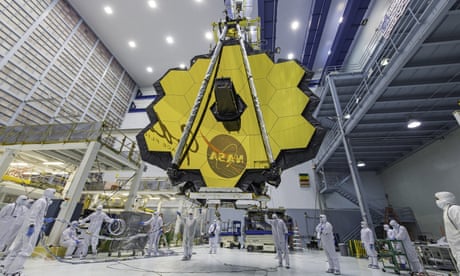The world’s most powerful telescope has made its first observations of a planet beyond our solar system, heralding in a new era of astronomy in which distant worlds can be scanned for signs of life. The observations, from Nasa’s James Webb Space Telescope, give new insights into the formation of the planet, a hot gas giant called Wasp-39bthat is 700 light years away in the Virgo constellation. They also provide the first clearcut evidence for carbon dioxide in the atmosphere of a planet orbiting a distant star.
“We want to know how unique we are and what the chance is of life elsewhere in the universe,” said Dr Vivien Parmentier, associate professor in physics at Oxford University and a member of the collaboration behind the work. “CO2 detection is typically one of the things we’re going to be looking for. This shows we have the capability, which is extremely exciting for all of us.
” A central aim of James Webb is to analyse the atmospheres of distant planets and search for biosignature gases that could indicate the presence of life on the planet below. Wasp-39b itself is not viewed as a promising candidate for life. The vast gas planet is about 1.
3 times the size of Jupiter, with an average temperature of around 900C. It is so close to its host star – about one-eighth the distance between the sun and Mercury – that it only takes around four Earth days to make a complete circuit. Its proximity to the star means it is likely to be tidally locked, with one side constantly facing towards its star and the other side shrouded in unending darkness.
The planet was discovered in 2011, after astronomers spotted subtle, periodic dimming of light from its host star, caused by the planet passing in front. The latest work goes further by measuring starlight that is being filtered through the planet’s atmosphere. Because different gases absorb different wavelengths of light, analysing the rainbow of starlight can indicate exactly which gases are present.
Previous results from the Hubble and Spitzer telescopes had given hints of the presence of carbon dioxide, but the latest observations, due to be published in the journal Nature, give the first conclusive evidence. Wasp-39b’s vast size and cloudless atmosphere made it an ideal first target. Astronomers now plan to apply the same techniques to analyse the atmospheres of smaller, rocky planets that are viewed as potentially habitable, such as those in the Trappist-1 star system .
They will be looking for Earth-like atmospheres, dominated by nitrogen, carbon-dioxide and water vapour and an overall balance of gases that hints at a contribution from biological processes. “We’re looking for a combination of gases that we can’t easily explain with our understanding of chemistry could indicate that something is producing it,” said Dr Jo Barstow, an astronomer at The Open University and a member of the JWST collaboration behind the paper. Sign up to Global Dispatch Free newsletter Get a different world view with a roundup of the best news, features and pictures, curated by our global development team Privacy Notice: Newsletters may contain info about charities, online ads, and content funded by outside parties.
For more information see our Privacy Policy . We use Google reCaptcha to protect our website and the Google Privacy Policy and Terms of Service apply. Observing planetary atmospheres will also help astronomers distinguish between small, rocky planets that are more Earth-like and those closer to Venus, which is sometimes referred to as Earth’s evil twin due to its blazing 470°C surface temperature and its dense, toxic atmosphere.
“It was probably a bit luck of the draw that Venus ended up so inhospitable and Earth ended up with life,” said Barstow. “It might’ve been a very small tipping point that drove them in such different directions. ”.
From: theguardian
URL: https://www.theguardian.com/science/2022/aug/25/webb-telescope-zooms-in-on-planet-beyond-our-solar-system



